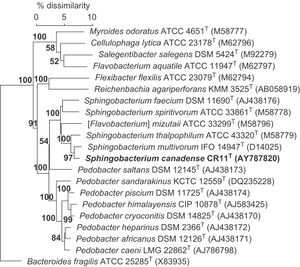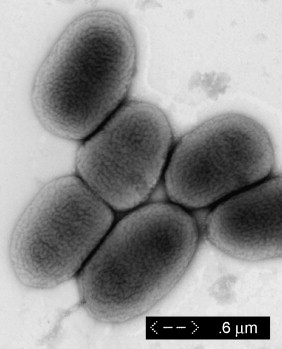Sphingobacterium canadense
Classification
Phylum:Bacteroidetes Order:Sphingobacteriales Family:Sphingobacteriaceae Genus:Sphingobacterium Species:Canadense
Description and significance
Sphingobacterium Canadense is a free-living Gram-negative bacterial. It was labeled as strain CR11 when isolated from corn root. This strain has important role in promoting the growth of corn. It has the closet 16s rRNA sequence with Sphingobacterium multivorum and Sphingobacterium. Thalpophilum, however they are not identical.
Identification
Sphingobacterium Canadense was thought to be a identifcal species as Sphingobacterium Multilvorum when it was first isolated. Polyphasic taxonomy was performed, including API20 NE and API50 CH bacterial identification kits, Biolog analysis, lipids and fatty acid analysis, DNA–DNA hybridization, 16S rRNA and cpn60 gene sequence analyses. In the result of these experiment, this strain was proved to be a new species in the genus of Sphingobacterium.

Comparison in fatty acid analysis
Identification of unknown bacteria started with testing a gas chromatograph (Agilent Technology, CA, USA; Model #6890N) and version 5.0 of the aerobe library (Microbial identification system (1993) Operating manual, MIDI, Inc., Newark, Del.) had performed to analyze the bacteria strain of CR11, Sphingobacterium multivorum, and Sphingobacterium Thalpophilum.
DNA–DNA hybridization
DNA-DNA hybridization was performed in order to observe the stability of the certain bacteria's structure as well as their G-C contents within the DNA. G-C contents can differ by each bacterias. Same bacteria would normally contain about same percentage of G-C contents. In the case of S. Canadense, it was compared with S. multivorum and S. Thalpophilum. The G-C content of the DNA of strain CR11(S. Canadense) was 40.5 mol% which is in accordance with the values for the genus Sphingobacterium (39–42 mol%; [15]). This made sure of strain CR11 that this bacteria is from Sphingobacterium genus. The G+C content of the DNA of S. Moltivorum was observed to be a 39.9-40.5%. These closely related numbers of G-C content represent that structure of these bacteria are very close, but does not prove that they are same species nor different species. However, DNA–DNA hybridization results showed that isolate CR11 had 11% DNA re-association with S. multivorum.
Morphology and cell characterization
Strain CR11 forms round colony , and after a couple days it will turn yellow color. This strain can grow in temperature at 20–37 °C, in pH 5–10, and concentrations of 0.5–3% NaCl. <https://microbewiki.kenyon.edu/index.php/File:Sphingo_canadense.jpeg>Fig. 1. Cell morphology of corn isolate CR11T under the electron microscope.
Author
Shohei Ueno, student in Michigan State University
Reference
Mehnaz S, Weselowski B, Lazarovits G. ”Sphingobacterium canadense sp. nov., an isolate from corn roots.”. School of Biological Sciences, University of the Punjab, 2007 Nov;30(7):519-24. Epub 2007 Jul 12.

